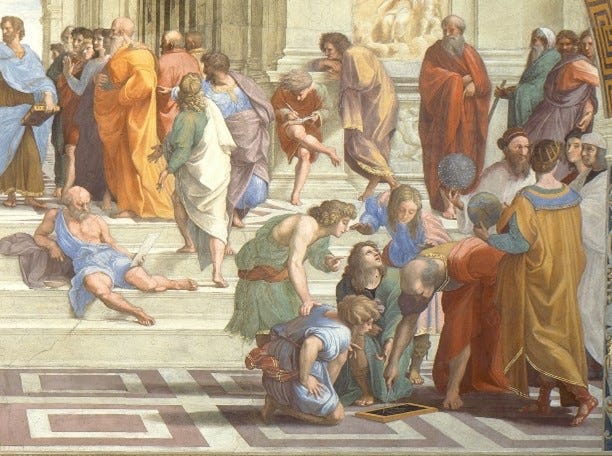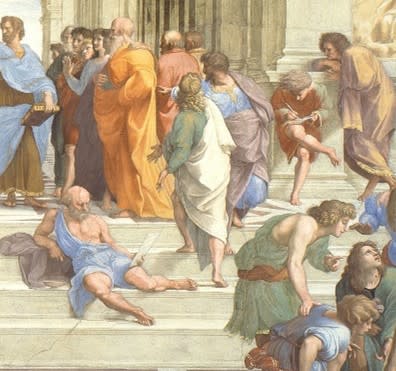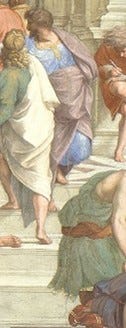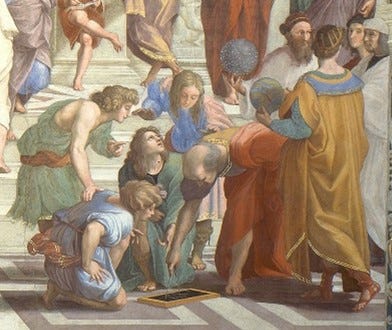THE DISCOVERY OF THE SCHOOL OF ATHENS
Part 9 – a way to the ‘Elements’
Now, we must leave the second scene at the top of the stairs, and move towards the third and last scene in the painting, and look at those persons who are found in the right foreground, at the bottom of the stairs.
And also, we must here leave our guide, Diogenes Laertius, who tried to show us a history of the development of the Greek philosophers. It seems that in his book, after discussing the followers of Plato, Diogenes Laertius discusses Antisthenes and Diogenes, the Cynics, and writes a long discourse on Zeno the Stoic, and on Epicurus, who he seems to admire the most.
But in our painting, this leads to a dead end – from Aristotle to Antisthenes and Diogenes, but that really leads to Marcus Aurelius and the fixing of the Four Chairs of Philosophy of the Roman Empire – i.e. the Peripatetics, the Cynics, the Stoics, and the Epicureans.
So, to find a way down the stairs, we’ll retrace our steps back to Plato’s successors, Speusippus and Xenocrates. And there seems to be a path that’s shaped like an arc, that runs from Xenocrates, to Speusippus, and then to three persons who lead us to that next scene at the bottom of the stairs.
Since this path seems to start at Xenocrates, we should recall that it was said that Xenocrates left us a great number of writings – ‘including six books on Mathematics, five books on Geometry, one on Arithmetic, and six on Astronomy’.
So, perhaps the way forward, after we saw the development of Greek philosophy from Thales to Plato, is the development of Greek geometry and astronomy, from Pythagoras to Plato.
And now, if we look in front of Speusippus, we will see someone who is beginning to go down the stairs – with one foot on the top of the stairs and the other foot on the first step, and who is also looking back, and with his right hand is pointing back, towards Plato. This could be Theaetetus.
And, if we look in front of that person, we’ll see someone who also appears to be walking down the stairs – with one foot on the first step and the other foot on the second step, and who is talking to Theaetetus, and is pointing with both his hands at the person who is sitting down on the steps. This could be Eudoxus.
And, in front of these two persons is someone who is sitting down and is spread out over the three steps, with one foot on the second step and the other foot on the third step, and who is reading from a page or a book. This could be Euclid.
The following sentence from Proclus, is why I think that these three persons could be Theaetetus, Eudoxus, and Euclid:
“Not much younger than these [pupils of Plato] is Euclid, who put together the ‘Elements’, arranging in order many of Eudoxus’ theorems, perfecting many of Theaetetus’, and also bringing to irrefutable demonstration the things which had been only loosely proved by his predecessors.”
First, let’s look at Theaetetus, a student of Socrates, who lived approximately from 417 to 369 BC.
Plato wrote a dialogue titled ‘Theaetetus’ where he describes him:
THEODORUS: “Yes, Socrates, I have met with a youth of this city who certainly deserves mention, and you will find it worthwhile to hear me describe him. If he were handsome, I should be afraid to use strong terms, lest I should be suspected of being in love with him. However, he is not handsome, but – forgive my saying so – he resembles you in being snub-nosed and having prominent eyes, though these features are less marked in him. So I can speak without fear. I assure you that, among all the young men I have met with – and I have had to do with a good many – I have never found such admirable gifts. The combination of a rare quickness of intelligence with exceptional gentleness and of an incomparably virile spirit with both, is a thing that I should hardly have believed could exist, and I have never seen it before. In general, people who have such keen and ready wits and such good memories as he, are also quick-tempered and passionate; they dart about like ships without ballast, and their temperament is rather enthusiastic than strong, whereas the steadier sort are somewhat dull when they come to face study, and they forget everything. But his approach to learning and inquiry, with the perfect quietness of its smooth and sure progress, is like the noiseless flow of a stream of oil. It is wonderful how he achieves all this at his age … His name is Theaetetus …”
SOCRATES: “You give him a noble character. Please ask him to come and sit down with us.”
And, Pappus also wrote about Theaetetus:
“The aim of Book X of Euclid's treatise on the ‘Elements’ is to investigate the commensurable and the incommensurable, the rational and irrational continuous quantities. This science has its origin in the school of Pythagoras, but underwent an important development in the hands of the Athenian, Theaetetus, who is justly admired for his natural aptitude in this as in other branches of mathematics. One of the most gifted of men, he patiently pursued the investigation of truth contained in these branches of science and was in my opinion the chief means of establishing distinctions and irrefutable proofs with respect to the above mentioned quantities. For Theatetus had distinguished square roots commensurable in length from those which are incommensurable, and who divided the more generally known irrational lines according to the different means, assigning the median line to geometry, the binomial to arithmetic and the apotome to harmony, as stated by Eudemus.”
And so, I think that this person should be Theaetetus, because it seems that this ‘investigation of truth’, that was began with Pythagoras, ‘underwent an important development’ in Theaetetus.
Next, we should look at Eudoxus.
The following is from ‘Lives and Opinions of the Eminent Philosophers’ by Diogenes Laertius:
“I. Eudoxus was the son of Aeschines, and a native of Cnidos. He was an astronomer, a geometrician, a physician, and a lawgiver. In geometry he was a pupil of Archytas, and in medicine of Philistion, the Sicilian, as Callimachus relates in his Tablets; and Sotion, in his Successions, asserts that he was likewise a pupil of Plato; for that, when he was twenty-three years of age, and in very narrow circumstances, he came to Athens with Theomedon the physician, by whom he was chiefly supported, being attracted by the reputation of the Socratic school. And when he had arrived at Piraeus, he went up to the city every day, and when he had heard the Sophists lecture he returned. And having spent two months there, he returned home again; and being aided by the contributions of his friends, he sent sail for Egypt, with Chrysippus the physician, bearing letters of introduction from Agesilaus to Nectanabis, and that he recommended him to the priests.
II. And having remained there a year and four months, he shaved his eyebrows after the manner of the Egyptian priests, and composed, as it is said, the treatise called the Octacteris. From thence he went to Cyzicus, and to the Propontis, in both of which places he lived as a Sophist; he also went to the court of Mansolus. And then, in this manner, he returned again to Athens, having a great many disciples with him ...
III. He was received in his own country with great honours, as the decree that was passed respecting him shows. He was also accounted very illustrious among the Greeks, having given laws to his fellow citizens, as Hermippus tells us in the fourth book of his account of the Seven Wise Men; and having also written treatises on Astronomy and Geometry, and several other considerable works.”
The ‘method’ developed by Eudoxus, is described by Lyndon LaRouche:
“Insofar as records exist, the more rigorous proof of existence of a class of magnitudes not congruent with rational numbers was developed by Plato's Academy, following the lines of prior work by Pythagoras et al. As the geometric proof of the famous Pythagorean theorem is exemplary of this conception, there exists a class of magnitudes in geometry which cannot be rendered congruent with rational numbers: incommensurable magnitudes, such as the hypotenuse of a right triangle. However, by use of the principle of geometric proportions, we can place these incommensurables between two magnitudes which are congruent with rational number orderings, showing that the incommensurable is less than the one of this pair, but greater than the other. This concept was embedded in a tactic employed by Plato's student and collaborator Eudoxus, the ‘Eudoxian method of exhaustion’ which was used by him, and other Greeks to perform an early form of integration, treating the incommensurable volume of a pyramid or cone, for example, as a subject.” [from ‘How Bertrand Russell Became an Evil Man’, July 1994]
“One drives a logical construction to beyond its limit, in the most rigorous way possible, searching for a devastating, axiomatic quality of ontological paradox in those extremes of vastness or smallness. Once such a paradox is provoked into appearing, the Eudoxian ‘method of exhaustion’ by means of which the paradox is evoked, is examined from the standpoint of the solution principle of Plato's Parmenides.” [from ‘The Truth About Temporal Eternity’, March 1994]
Because Eudoxus (in collaboration with Plato) was so important in continuing the work of Theaetetus, I think that this person should be Eudoxus.
And now, we should look at Euclid. Although very little is known about Euclid, since Proclus said that he was younger than the pupils of Plato, but older than Eratosthenes and Archimedes, it is supposed that he lived approximately from 325 to 265 BC. Euclid may have been one of the first scholars at the Museum of Alexandria, during the reign of Ptolemy.
The following is from Proclus:
“This man lived in the time of the first Ptolemy; for Archimedes, who followed closely upon the first Ptolemy makes mention of Euclid, and further says that Ptolemy once asked if there were a shorter way to study geometry than the Elements, to which he replied that there was no royal road to geometry. He is therefore younger than Plato's circle, but older than Eratosthenes and Archimedes; for these were contemporaries, as Eratosthenes somewhere says. In his aim he was a Platonist, being in sympathy with this philosophy, whence he made the end of the whole ‘Elements’ the construction of the so-called Platonic figures.”
Euclid wrote the following books which have survived: ‘Elements’, ‘Data’, ‘On Divisions’, ‘Optics’, and ‘Phaenomena’, and those books that have been lost: ‘Surface Loci’, ‘Prisms’, ‘Conics’, ‘Book of Fallacies’, and ‘Elements of Music’.
Some 600 years later, in the 3rd century AD, Theon of Alexandria edited ‘Euclid’s Elements’ and this is the version that has been studied since then. Whether this version is the same as Euclid’s original book, or whether it has been changed or altered, has been the subject of much controversy, as well as how the system of Euclid is viewed differently, by the followers of Aristotle and the followers of Plato.
The following is from ‘How Hobbes’ Mathematics Misshaped Modern History’, Jan. 1996, by Lyndon LaRouche:
“Until Bernhard Riemann's 1854 habilitation dissertation, all those formalities of the classroom mathematics which are generally taught still today, were derived from a model of geometry adopted from Euclid’s Elements. The materialist and empiricist view of that geometry, was based upon the presumption that the four dimensions of Euclidian-Cartesian space-time, were each and all extended into ‘bad infinity’ without limit, and were extended everywhere, always with perfect continuity. The materialist version of this, assumed that those four dimensions were supplied to an Aristotelian tabula rasa, the newborn human mind, by the human senses, whose sense-impressions were presumed to be a reflection of the composition of the material universe outside the human mind itself. The empiricists made more limited claims respecting the alleged reality of sense-perceptions, but shared with the materialists the presumption that all knowledge was limited to those ‘facts’ attributed to the self-evident authority of isolable sense-impressions.
In the real world, which exists only outside such presumptions of Aristotelean virtual reality, the increase of the potential relative population-density of the human species, from the level of a putative man-ape several millions living individuals at most, to the vastly higher population-levels and life-expectancies of civilized existence, is the result of categories of ideas which violate the empiricist’s and materialist’s presumptions respecting sense-perceptions, and respecting ideas as defined by Plato.”
And this is why I think that this should be Euclid, who may be the one sitting down, because he was the one who wrote down the theorems of Theaetetus, and Eudoxus, and the many earlier Greek scholars. And because Euclid studied at the Academy in Athens and then taught in Alexandria, it seems to show how the method of Plato and Theaetetus and Eudoxus, led to the later discoveries of the School of Alexandria.
Next, we should look at the scene at the bottom of the stairs, to see where next our search could lead us.
[ next week – part 10 – the school of Alexandria ]










Any idea of the identity of the figure writing in a book with hair blowing in the wind?